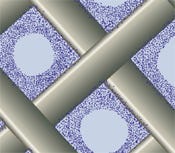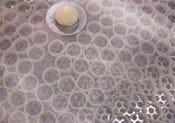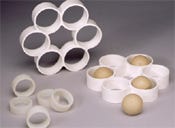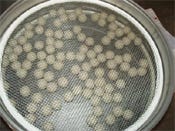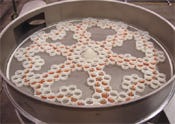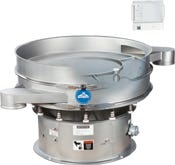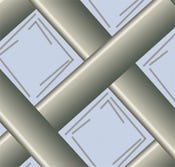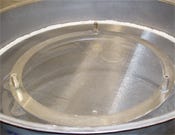Vibratory Screen-Cleaning Methods Improve Efficiencies, Save Money
October 8, 2007
|
|
Figure 1: (above) Trapped near-size particles prevent screen openings from performing further material classification; (below) fine-material buildup or caking prevents the screen openings from performing further material classification. |
Screen blinding occurs when screen-mesh openings are blocked or closed by the material being screened. Near-size particles become trapped or build up on the wires, effectively blocking the screen openings and preventing further material from passing through the screen. Figure 1 (above) shows trapped near-size particles that prevent screen openings from performing further material classification, while Figure 1 (below) shows fine-material buildup or caking, which also impedes further material classification. Common screening problems, these phenomena are easily fixed using screen-cleaning devices. This article reviews the most common methods of screen deblinding.
Bottom-Side Screen-Cleaning Devices
Sliders, ball trays, and sandwich screens are bottom-side devices for cleaning screens.
Sliders. The most common self-cleaning device is the slider. Slider rings are loose devices that slide directly beneath the screen on a slider support surface, which normally consists of a perforated metal plate. The rings are bounced vertically into the screen mesh by the vertical motion of the separator as they travel radially around the screen. The sliders are activated by the motion of the separator without the need for an additional driving force. Sliders are especially good on fine mesh because of their low impact energy and their shearing wiping action, which cleans the screen openings. They can be used in both wet and dry screening applications.
Sliders work by four different methods, depending on the material properties:
1. Vertical separator motion impacts the slider ring on the bottom of the mesh, dislodging trapped near-size particles from the screen-mesh openings. This process effectively cleans the screen and opens the mesh for the next particle to be screened.
2. The slider shears or breaks protruding hard or friable materials into smaller pieces, which flow through the screen and clear the openings.
3. If the material is soft and pliable, the sliders can help the material through the screen openings.
4. If the material is fibrous, the sliders’ horizontal scrubbing motion across the bottom of the screen dislodges trapped fibers from the screen openings, improving throughput capacity.
|
Figure 2: Sliders travel across the top of a perforated plate. The motion of the vibratory separator throws the sliders into the screen as they rotate around the center of the machine. |
Sliders are not efficient for materials that tend to ball up or agglomerate inside the sliders. They also generate minor amounts of heat, which can fuse temperature-sensitive materials. In addition, sliders may not perform well on extremely hard, irregular-shaped materials, which can partially protrude through the screen opening and stop the motion of the slider.
Slider clusters work on essentially the same principles as slider rings. The difference between them is that the slider cluster is four to eight times larger than the slider ring. Slider clusters are normally used for large-diameter machines for easier maintenance. While the impact force of the slider cluster is greater than that of the slider ring because of its larger weight and size, it has less impact on the screen because a small number of clusters are required. Figure 3 shows single slider rings (lower left), slider clusters (center top), and slider clusters with rubber balls (lower right).
Opinions vary as to which self-cleaning method is more effective: individual sliders or larger slider clusters. In fact, their effectiveness depends entirely on the material being screened.
|
Figure 3: Single slider rings (lower left), slider clusters (center top), and slider clusters with rubber balls (lower right) |
Ball Trays. Rubber balls are the second-most-utilized screen-cleaning method, but they can be used only for dry screening. The rubber balls are generally 13/8 in. in diameter and are supported by a second, coarser mesh 2 in. below the classifying-screen mesh. Higher vertical separator motion is required to activate the balls’ cleaning action because the balls must be thrown up against the bottom of the screen. As shown in Figure 4, self-cleaning kit balls bounce between a support screen and the classifying screen. The vertical motion of the separator launches the balls and generates the screen-cleaning action.
Because of their larger vertical motion and heavier balls, ball trays cause a greater impact than either sliders or clusters. As a result of the higher impact energy, the balls are generally used for coarse meshes that can withstand the higher energy. Such balls are not recommended for fine screen meshes because they can damage the mesh.
|
Figure 4: Self-cleaning kit balls bounce between a support screen and the classifying screen. The separator’s vertical motion launches the balls and causes cleaning. |
Balls are good at cleaning the near-size irregular or jagged-shape particles that wedge in mesh openings. These materials can trap sliders. Balls are also good for shear-sensitive materials, which can cause smearing or balling agglomeration. However, balls are not recommended for cleaning fibrous materials because they do not perform the shearing action that is necessary for dislodging fibers from the mesh.
The disadvantage of ball trays is that the balls spread radially to the periphery of the screen. This generates excellent cleaning action at the screen edge but leaves the center of the screen uncleaned.
Sandwich Screens. Sandwich screens are made by bonding a classifying mesh to the top of the screen tension ring and by bonding a coarser support screen mesh to the bottom of the ring. This creates a sandwich in which screen-cleaning devices float between meshes. The sandwich construction improves cleaning action, decreases maintenance costs, and reduces noise levels.
Sandwich screens improve cleaning action because sliders are more active at bouncing off the bottom mesh than a standard perforated metal plate. The bottom mesh acts more like a trampoline, launching cleaners into the mesh. This construction also positions the cleaners closer to the classifying mesh, enabling a more gentle vibratory motion that provides better cleaning action.
In sandwich screening, screen and motor life are increased because the improved cleaning efficiency requires less vertical vibration amplitude than standard sliders and balls. With increased screen and motor life, maintenance costs are also reduced. In addition, sandwich screens’ cartridge design enables faster screen changes.
Sandwich screens allow the use of sliders that contain a combination of smaller balls, which can yield better results than sliders or balls individually. The sliders provide complete coverage of the screen surface and hold the balls in position, providing ball cleaning action across the entire screen. Smaller balls yield ideal impact energy and can be used on fine meshes.
Sandwich screens can be used for dry or wet screening and can be fabricated with metal or synthetic meshes. Sandwich-screen bottom-screen meshes are much better for wet screening because, unlike perforated plates, they do not allow liquids to build up. Finally, sandwich screens are quieter than other screen-cleaning methods.
Top-Side Screen-Cleaning Methods
In addition to bottom-side self-cleaning methods, top-side cleaning devices that reside on top of the classifying-screen mesh can be used. These devices can be divided into three types: brushes, wipers, and dams.
Top-Side Rotary Brushes. Top-side rotary brushes are of exceptional utility for clearing fibrous materials that tend to mat on top of the screen and block the mesh openings. Propelled by the vibratory motion of the separator, these brushes move around the screen diameter. No additional driving motors are required. After the brushes ball up the fibrous mat above the screen to expose the screen openings, the fiber balls are then discharged from the top of the screen and removed through a spout.
The disadvantage of top-side brushes is that their bristles can enter the product stream.
Top-Side Necklace Ring Dams. Top-side necklace rings create a radial edge dam that keeps materials on the active screen longer. The longer some materials are on the screen, the higher the throughput capacity. This method can increase the yield of smaller machines to match the capacity of larger machines.
|
Figure 5: A top-side wiper ring slides around on top of the screen in order to help clean the mesh openings. |
Top-Side Wiper Rings. Top-side wiper rings provide the same radial edge dam as necklace rings but also contain a wiper that performs a shearing action. This action can wipe fatty materials through the screen mesh or break up friable clumps, improving capacity or reducing loss. The disadvantage of top-side wipers is that they slow or impede material flow through the machine. They should never be used with materials that tend to ball up. Figure 5 shows a top-side wiper ring sliding around on top of the screen to help clean the mesh openings.
Vibro-Rim Screens. Vibro-rim screens contain metal ball bearings inside the hollow screen-tension ring. When they are moved by the vibratory motion of the separator, the balls create a secondary vibrational energy by impacting the screen tension ring. This impact energy is transmitted to the screen mesh through the ring. The resulting excitation helps clean the radial edge of the screen. This technique is good for synthetic meshes that can sustain unacceptable wear and damage from sliders or balls. The disadvantage of vibro rim screens is that only the outer two inches of the screens are excited and cleaned.
|
|
Figure 6: (above) An ultrasonic screen-cleaning system installed in a round vibratory separator. The externally mounted electrical control box powers the transducer affixed to the screen tension ring. The screen is bonded to the exciter ring, which vibrates the mesh; (below) ultrasonically vibrating screen mesh. |
Water Sprays. Water sprays clear screen mesh openings, help eject solids, and keep slurries from drying out and building up inside separators. Moreover, they do not cause the types of contamination associated with sliders, balls, or brush materials. However, the use of liquid sprays results in additional costs and can dilute products.
Stationary spray nozzles are good for cleaning mesh openings and washing fine particles from oversized solids, while rotary spray nozzles are good for deblinding and ejecting fibrous or lint-type materials.
Ultrasonic Cleaning. Ultrasonic screen cleaning uses vibrational energy generated by an ultrasonic frequency transducer attached to the metal screen mesh. This method is good for high-accuracy applications in which the particle size approaches the size of the mesh opening. Ultrasonic energy breaks down electrostatic charges and surface tension, which agglomerate particles and prevent efficient screening. Figure 6 (above) shows an ultrasonic screen-cleaning system installed in a round vibratory separator. The externally mounted electrical control box powers the transducer affixed to the screen tension ring. The screen is bonded to the exciter ring, which vibrates the mesh. Figure 6 (below) illustrates an ultrasonically vibrating screen mesh.
The ultrasonic vibrational amplitude is 0.000005 in. and occurs at a frequency of 35,000 times/sec. The lower amplitude and increased frequency mean that particles land on the screen openings approximately 1000 times more often than with standard separator vibration, increasing the statistical chance that the particles will go through the mesh opening.
|
Figure 7: A screen energizer attached below the screen surface |
Ultrasonic screen cleaning is the most expensive separation process. Ultrasonic equipment costs are 10 to 20 times the cost of sliders, and consumable screens cost four times more than the screens used with other methods if a tension-ring rescreening program is implemented. Therefore, ultrasonic screen cleaning is only used with high-value mateials and in difficult screening operations that cannot be performed efficiently using any other method.
Energizers. Energizers are pneumatic screen vibration generators that operate at frequencies and amplitudes between ultrasonic motion and standard round separator motion. Pneumatic screen energizers can be used on both synthetic and metal screen meshes. Figure 7 shows a screen energizer attached below the screen surface.
Multiple transducers generate a more uniform vibration across the entire screen surface, even on large-diameter screens. Pneumatic generators do not use electrical energy and require only simple mechanical maintenance.
Energizers achieve high-frequency screen excitation at a lower cost than ultrasonic cleaning. Energizer systems cost one-third the price of ultrasonic equipment, while disposable screens cost one-quarter the price of ultrasonic screens.
Greg Brock is a technical support representative at Sweco in Florence, KY, a worldwide leader in particle-separation and size-reduction technologies. Brock can be reached at 800-849-3259 or [email protected].
About the Author(s)
You May Also Like


